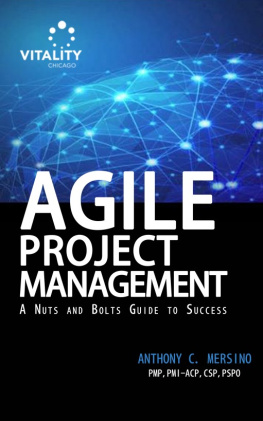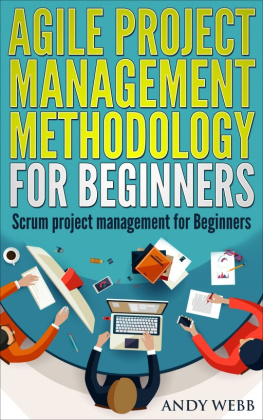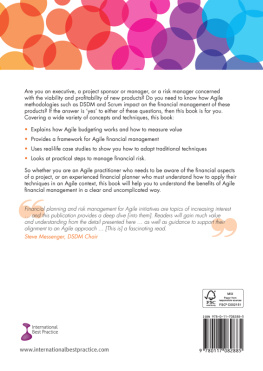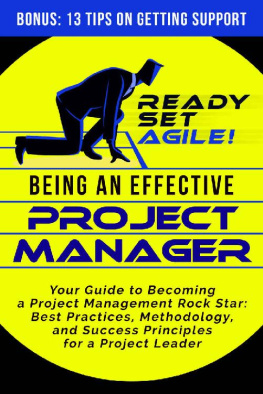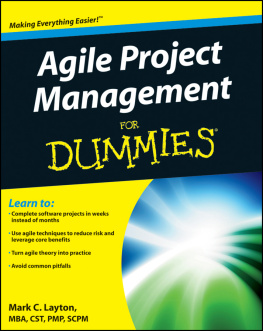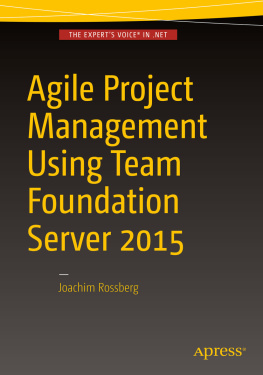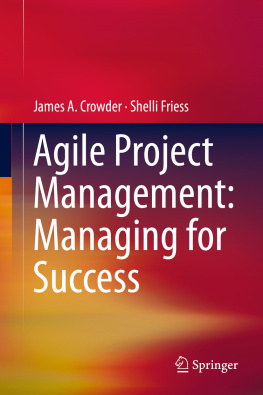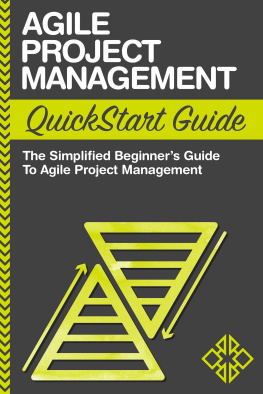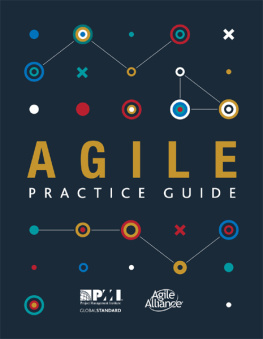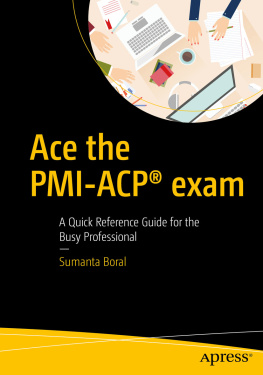Agile Project Management
A Nuts and Bolts Guide to Success
First Edition
Anthony C. Mersino,
PMP, PMI-ACP, CSP, PSPO
Vitality Chicago
197 Latrobe Ave
Northfield, IL 60093
www.VitalityChicago.com
Copyright 2015 by Anthony C. Mersino
All rights reserved. This book or any portion thereofmay not be reproduced or used in any manner whatsoever without theexpress written permission of the publisher except for the use ofbrief quotations in a book review.
Printed in the United States of America
Smashwords Edition
May 31, 2015
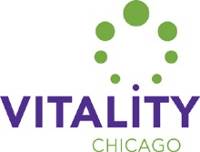
Vitality Chicago
197 Latrobe Ave
Northfield, IL 60093
www.VitalityChicago.com
To Norma thanks for all the laughs!
Contents
Acknowledgments
Writing this bookwas different. In my previous books, I toiled alone to get the workdone. With this book, I had a terrific team supporting me andreviewing my work and that made a huge difference in the quality ofthe end product. It was also a lot more fun, and more appropriatefor a book on Agile.
Two people that made significantcontributions as reviewers were David Gonzalez and Tom Cagley.David was usually the first person to read and comment on eachchapter as I made it available. His perspective as a project andprogram manager was very helpful. Tom Cagley also reviewed andprovided his views as an Agile Coach and a thought leader insoftware development. Thank you both!
A number of others contributed valuableinsights. Sam Siegel applied his Agile experience and editorialbackground to identify a number of unclear or inaccurate items.Malena Zamora offered personal insights and identified areas thatwere not as clear as they needed to be. Steve Pasek brought deepAgile knowledge and a sense of humor to the project. A number ofothers read and provided feedback including Audra Lawlor, AndyDeMarco, Tushar Patel, Greg Brown, Mike Lane, Kevin Ruane, andJanet Gedwill.
Dick Riederer did an amazing job in hiseditorial review. I envy his keen eye and his proficiency in thenuances of the English language. He was fast and efficient.
Finally, I need to acknowledge the supportprovided by my home team. They gave me space and allowed me tofocus on writing. This included Krista, Jack and of course mywonderful wife Norma. You guys were awesome!
Thank you all very much!
Anthony
Introduction
Over the lastdecade, Agile techniques have grown in prominence. In fact, so manyorganizations have experimented with Agile that nearly everyone haseither tried it or heard from others who have. And with anythingnew comes change and resistance to change. Agile seems to havecreated two camps ardent followers and those who are opposed toit.
There are many reasons I have heard foropposition; Agile wont work for us, nothing new under the sun,doesnt provide benefits. On the other hand, there are lots ofsuccess stories with Agile so I think there is something to belearned from that.
Having a long experience with traditionalproject management and program management, I can empathize withtraditional PMs and their reluctance to embrace agile. Traditionalproject management is about trying to manage the unmanageable time, cost and scope. A significant amount of experience, good andbad, went in to the creation of a project management body ofknowledge. The intent of the PMBOK is to provide a set of bestpractices that can be tailored to the situation at hand.
Though I was first exposed to Agile in 2003,Ive only been working, studying, applying and teaching Agiletechniques since 2008. In the process, Ive had to unlearn somethings and embrace concepts that were very different than myprevious experience as a project manager. Ive also found that manyof the challenges I felt as a project manager were addressed betterby Agile techniques, especially when it comes to managinguncertainty and providing predictability.
This book is intended to help projectmanagers, developers, managers and other team members who arefamiliar with traditional methods to understand Agile concepts andtechniques and be able to apply them when the situation warrantstheir use.
Why This Book
There are many books about Agile on themarket and very few that are targeted to or address projectmanagers. In fact, the average PM is likely to be bewildered by thevolume and variability of the information that is available. Thebooks that are available vary widely in quality, scope andpractical application. Ive referenced several of them for thisbook. The at the back of this book provide moreinformation for further exploration of this topic.
Likewise, there are few trainingopportunities for a project manager trying to get up to speed.PMIs introduction of the Agile Certified Practitioner (PMI-ACP)certification was an attempt to bring Agile to project managers.Ive taught the PMI-ACP preparation training course and it is justa flood of information that the participants need to know in orderto pass the exam.
The intent of this training book is to helpproject managers better understand Agile methods so that they canapply them successfully.
The book is a mix of theory and practicalapplication, with a fair number of real world examples and storiesthroughout. There is no one size fits all with Agile. Also, Agileis new enough that the idea of best practices is a few years off.Rather, there are examples where good practices might work in aparticular situation. Where possible, Ive incorporated both andoffered my explanation for why things did or did not work out.
Project success rates, at least for ITprojects, have been rather low over the years. There are severalreasons for the low success rates including faulty assumptions,poor requirements, treating plans as certainty in uncertainenvironments and holding project managers responsible forunrealistic goals. Unfortunately, we often ignore these underlyingcauses.
Agile practices address some of theseunderlying causes by fundamentally changing the way project work iscompleted. It is no surprise then that Agile projects are 3X morelikely to succeed than traditional projects. (Cohn, 2012)
Agile means many things to manypeople
One of the objectives is to help readersunderstand the Agile landscape. Agile is an umbrella word thatencompasses other concepts like Lean, Kanban and Iterative andIncremental Development. It has also been misused to describeorganizations that follow no methodology or chaos. For thesereasons, Agile has come to mean many different things topeople.
For example, some think of Agile assynonymous with Scrum, the predominant approach. You can be Agilewithout using Scrum. But so many companies are implementing Scrumthat they treat Agile and Scrum as the same thing. They arent.
Rich History
While to many, Agile is considered aradically different way of doing things, it really isnt. At theheart of Agile is iterative and incremental approaches, rather thanplan driven development. Modern Agile incorporates key elements ofLean from the Lean Manufacturing techniques perfected by Toyota,cross functional teams used for new product development andIterative and Incremental Development used for software developmentsince the 1970s.
By understanding the roots of Agile, projectleaders can better understand and leverage these concepts forsuccessful project outcomes.
Agile Means No ProjectManagers
Perhaps you have heard that teams that areusing Agile dont need a project manager to manage them. The teamsare self-organizing and they work together to get done what needsto be done. This can be tough for traditional project managers toaccept.
Some Agile proponents seem to have areligious or militant leaning, and make a big deal out of this. Oneof the most popular Agile methods, Scrum, is clear that there is norole for project managers. Further, the role of Scrum Master on aScrum team is so different from a traditional project managementrole that Scrum proponents dont believe that traditional PMs canfunction in that role.
Next page
